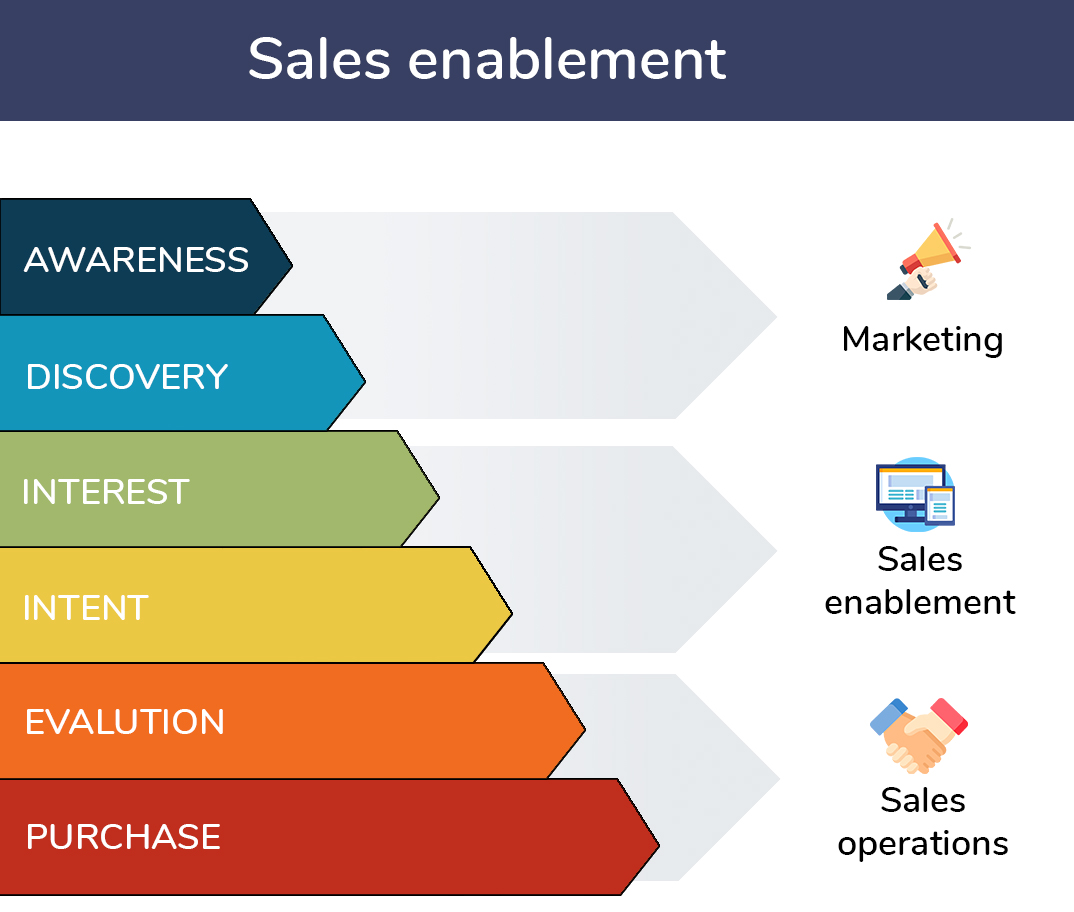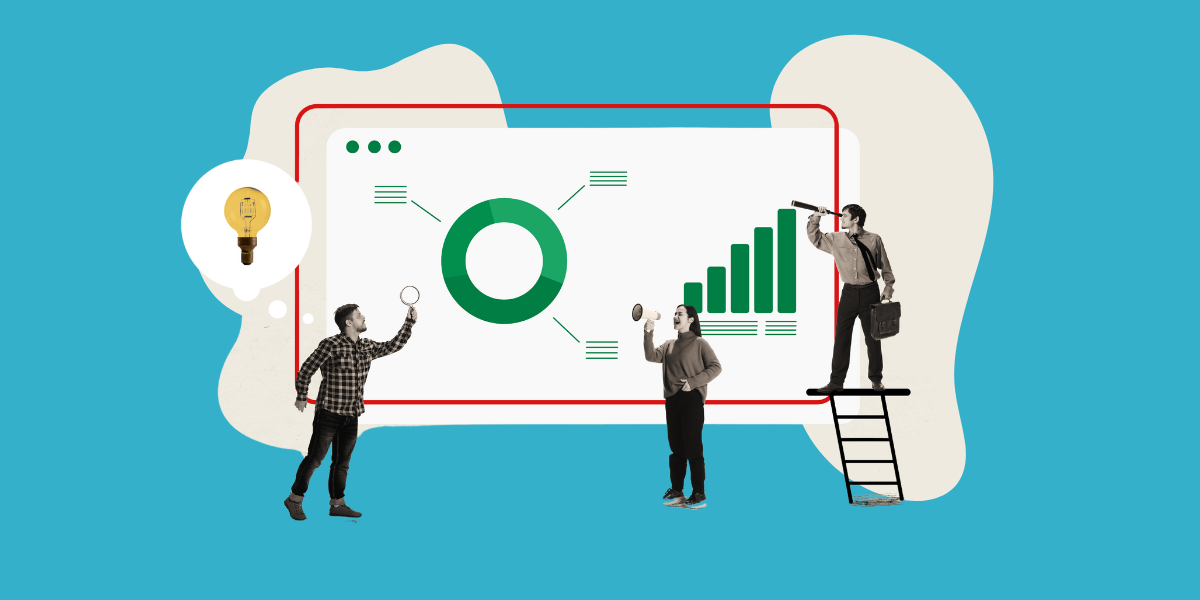How to create a sales enablement content strategy
In this blog
- What is sales enablement content?
- Why do you need sales enablement content?
- Sales enablement platforms and strategies
- With and without sales enablement
- Creating the right sales enablement content
- Creating a sales enablement content strategy
- 1. Go straight to the source
- 2. Look at what you already have
- 3. Map content to the buyer journey
- 4. Spot the blockers outside of sales and marketing
- 5. Create content to fill the gaps
- 6. Store content in a central place
- 7. Collect all prospect information in one place
- 8. Learning and development
- 9. Feedback and analysis
- Making your sales enablement content strategy a success

Where do you start with creating a sales enablement content strategy? Here’s how to put a plan together.
Developing a sales enablement strategy may not be the most exciting thing you do this year. Your new strategy could accelerate sales and help smash targets, and you probably won’t be rewarded with a massive bonus and tearful thanks at the Christmas party.
Those honours often go to the sales team. They’re the ones greasing wheels and signing deals. But there are ways to make a big impact even when you’re not front and centre.
Sure, at Sopro Towers it’s the sales gang ringing the gong when they close another sale, but who’s serving up all those juicy leads thanks to killer blog posts with whimsical intros? I think we know who the real hero is here.
Sales enablement content might not be doing the actual selling, but it might just help you sell more.
What is sales enablement content?
Sales enablement is the process of empowering sales agents to sell more. Sales enablement content is any content created and distributed that helps sales teams close more deals.
It provides the strategies, tools, processes and content that a seller needs throughout the sales cycle. Sales agents can then find, connect and engage more effectively with prospects.
Sales enablement content makes sales agents more effective and efficient at selling. It allows them to focus on what they do best: pitching, selling, and increasing sales productivity.
This content is specifically geared towards handling objections, showing social proof and demonstrating value for potential customers. It aims to answer any questions your prospects may have and therefore makes your sales team’s job easier.
That’s the simple explanation. Let’s go into a little more detail below.

Sales engagement vs sales enablement
Discover the difference, why you need both, and how they form a key part of your B2B sales strategy.
Read moreWhy do you need sales enablement content?
If you want someone to do something efficiently, giving them the right tool to do it is the best place to start. That’s what sales enablement content does – it enables your sales teams to convert leads and boost your business’s revenue.
1. Cover more touchpoints
Customers should be provided with content throughout each stage of their buying journey – this can take the form of different resources such as interactive tools, detailed guides, or explainers.
A successful content marketing strategy involves mapping content to the sales funnel. Prospects find the right content at the right time.
65% of marketing content goes unused. Sales teams need to work with marketing to ensure content delivers value at different stages of the journey.
Today’s customers have more choice than ever, so if your sales team can’t give them what they need on their buying journey, they won’t hesitate to go somewhere else.
2. Let sales reps focus on selling
On average, sales reps spend a mere 35% of their time selling. We’re passionate about helping teams improve this. Our prospecting service frees up reps to focus on what they do best: selling. Sales enablement does the same thing. It helps them sell more.
Modern customer journeys take place across many touchpoints. A sales enablement strategy places this customer journey at the centre of sales.
3. Up the personalisation
The focus on buyer preferences, pain points and personas help sellers to adopt a tailored approach. Reps enjoy superior insight into each lead, opening up more purposeful conversations and faster closing of deals.
4. Get sales and marketing working together
Sales and marketing alignment isn’t just about content marketing. But content is an important part of a sales enablement strategy. Sales enablement help reps succeed, and reps with strong results are more likely to engage with their jobs and stay long term.
5. Improve client retention
A sales enablement plan is mainly concerned with signing new customers. But the process of designing this plan will also improve the experience for existing customers. Sales enablement is closely related to sales and marketing alignment. But barriers to sales can exist anywhere in a business.
Sales enablement platforms and strategies
There are many paths to sales enablement:
- Sales training
- Prospecting and lead qualification
- Tech solutions
- Content strategy
You can focus on any one of these or a mix of all four. Anything that improves sales effectiveness can be part of a sales enablement action plan.
With and without sales enablement
| Without sales enablement | With sales enablement |
|---|---|
| The sales team waste time searching for content that may or may not fit the bill. | They have instant access to content. It is tailored for each stage of the buyer journey. |
| Content is stored on multiple platforms. It wastes time and content goes unused. | There is a single platform for all sales enablement collateral: training, marketing and analytics. |
| Sales and marketing are misaligned with different performance metrics and goals. | Sales and marketing are aligned. Both pursue tactics and goals based on growing revenue. |
| The marketing team can’t tell which content is performing well or who it performs well with. | Marketers have access to data so they can create content that moves prospects along the funnel. |
| Lack of structured support makes it harder to attract and retain sales talent. | An attractive working culture for top sales talent. |
Creating the right sales enablement content
We’ve established what sales enablement content is and why it’s important. But where do you start with creating these resources? Here are some effective types of sales enablement content:
Ebooks and whitepapers
In-depth, valuable content builds trust and credibility, and reinforces your authority in your area of expertise. Ebooks and reports offer a detailed form of content that allows you to get stuck into the details.
Product demos
Show, don’t tell. Short, clear videos that a customer can watch in their own time will help your team convey the reality – and value – of using your product or service.
Case studies
There’s no better advert for your business than a happy customer. Case studies that are relatable to your prospects (i.e. in the same industry or targeting the same people) are one of the most effective tools for boosting conversions.
Email templates
Save your sales team’s time and effort by standardising some email templates for different stages of the buyer journey. Having template text that reps can grab quickly – rather than create from scratch repeatedly – is a great tool to have in your sales arsenal.
While it can cut out most of the menial work, effort should still be taken to ensure emails are personalised and relevant to the individual prospect.
Sales enablement tools
This will depend on your situation, goals and strategy, but common sales enablement tools include:
- Sales CRMs
- Sales intelligence software
- Content management platforms
- Customer experience management tools
- Sales and marketing automation software
- Sales enablement AI and predictive analytics
You might also like
Read our guide to the different types of sales enablement content that can boost sales.
Creating a sales enablement content strategy
It’s easy to dismiss content as top-of-funnel marketing. But the best sales enablement content comes about when the sales and marketing teams are aligned and working together. Here’s how to get started with sales enablement content.
1. Go straight to the source
Get feedback directly from the people who experience it. Your sales reps will know the most common questions, issues, and pain points that come up at each stage of the buying process. Your marketing team sees these insights as solid gold for creating content – so together they make the perfect recipe for sales enablement material that actually does the job!
2. Look at what you already have
Not all of your existing content will work for sales enablement, but you’ve probably got some hidden gems hiding in your blogs, presentations, and web pages. Save time and effort by auditing what you already have, you’ll then see what pieces can be used to address the pain points and issues you identified in the previous step.
3. Map content to the buyer journey
Do you know what your buyer journey actually looks like? Try mapping out the stages of your sales funnel from your customers’ perspective. From this, you’ll be able to clearly spot opportunities to create or reuse content that aligns with each touchpoint.
Think of content in three stages. Marketing brings in the leads by driving brand awareness. Once in the sales pipeline, sales enablement takes over, moving prospects along until sales operations takes over in the later stages.
Reps need different resources depending on where prospects are in the sales pipeline. You need to understand which parts of the journey you have covered and which are missing.
What tends to happen without sales enablement is marketing focuses on attracting prospects.

4. Spot the blockers outside of sales and marketing
Content is our main focus, but we’re not just focusing on sales and marketing teams here.
Finance, customer service, product development, competitor analysis: all will impact your sales enablement strategy.
Barriers often come when the buying process is not aligned with your buyer personas and customer profiles. Enabling sales starts with understanding your customers.
5. Create content to fill the gaps
If marketing KPIs focus solely on lead generation then the team’s focus will be on raising brand awareness and bringing in those initial leads. Sales enablement shifts the focus to also include improving sales readiness.
Sales enablement content should convince prospects who are in the intent/evaluation phase that your solution is the perfect fit.
Providing up to date, relevant content to the right person at the right time is the basis of buyer enablement, and it supports sales conversations in tandem with sale enablement.
One classic example of sales content is case studies. These are unlikely to raise awareness but can be vital to demonstrate the effectiveness of your solution in a particular use case or industry.
Case studies should be created with sales, marketing and client services in alignment, to fill any identified gaps.
6. Store content in a central place
65% of content goes unused. That happens for two reasons: it’s either unusable or unfindable.
Mapping content to the user journey and creating content to fill any gaps should fix the first problem. The second problem can be summed up by the following statistic:
62% of businesses report that sales collateral is stored in six or more locations.
Storing it in a central place, and making it easy to search (by stage, industry, use case, etc) will increase content use, sales enablement takeup, and ultimately, sales.
7. Collect all prospect information in one place
This can be difficult to fully achieve depending on tech, but you can move towards a single customer view even if you can’t get fully there.
Providing campaign activity, any previous correspondence and contact information in one place can save salespeople valuable time. Importantly, this can be used to engage with prospective customers in a more contextually relevant way.
This point highlights how important it is to get buy-in from all parties: salespeople must track and save ongoing information for later conversations.
8. Learning and development
There’s no point in spending time and resources on building these processes if the sales organization doesn’t want or know how to use them.
Training should demonstrate the value of good sales enablement practice. But sales enablement should also integrate with wider development programmes.
Sellers should be able to use any technology available, but should also understand current techniques and changes. How many teams have trained on the changing face of sales in the world of remote selling, for example?
9. Feedback and analysis
The last point is to remember that a sales enablement strategy is an ongoing process. Collect feedback. Analyse the resulting data. Always try to improve.
Any content that’s been sent to your prospects should be tracked and analysed. Did they click that link? Did they read/watch the whole way through? What was the piece that sealed the deal? Content that gets high engagement should set the bar for any future content.
But remember, not everything you create is going to land. Sometimes you’re convinced that a piece of content is killer, only to be met with tumbleweed. That’s ok! We learn by doing, and there are valuable insights to be had at every point of the buyer journey. Sales enablement never ends. New product launches, new technology and new audiences all mean your sales enablement strategy will need updating.
Making your sales enablement content strategy a success
To measure and improve your sales enablement, you need key performance indicators (KPIs) that will help you measure your success.
These may include:
- Lead to conversion rate
- Sales velocity
- Quota attainment
- Content usage
Sales enablement can help you sell more. Sopro’s prospecting delivers a reliable flow of leads, every day. So we help you sell more too. Get in touch to find out more or request a demo.
.
Looking for lead generation services for marketing and advertising agencies? Or maybe you’re after a lead generation agency for training and coaching services. Look no further than Sopro. We’ll develop messaging that resonates with the decision-makers you need to sway.







Share